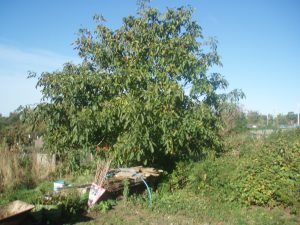I had a little nut tree
Nothing would it bear
But a silver nutmeg
And a golden pear.
The King of Spain’s daughter
Came to visit me
All for the sake
Of my little nut tree.
This nursery rhyme is said to commemorate the visit of Katherine of Aragon to King Henry VII’s court in 1506.

My walnut tree does not have such an illustrious provenance, it started life as a walnut that I found on the lawn of a pub called the Walnut Tree, which as its name suggests had an ancient walnut tree growing in its garden, in Weston-super-Mare in the autumn of 2000. When I asked the land lord what he did with all the nuts on the ground he said, “Oh the squirrels take them, help yourself to as many as you like”. I brought some home to Twyford, ate some, and planted several in a large flower pot. The following spring only one germinated which I kept in the pot until I retired in 2002 and took over a very overgrown allotment where I planted it. It did not produce any nuts until it was six years old and about ten feet high when I had a crop of six nuts, since then, as it has grown, it has produced more and more each year, last year was a relatively poor year due to the wet weather in the spring, even so there was a crop of over a hundred. The tree is now sixteen years old being about 20 feet tall although I have reduced its height by pruning the leading shoots each year. The new nuts are not like those in the shops,
In the spring, before the leaves fully appear the walnut tree produces catkins, about the size of an adult’s index finger and very small insignificant flowers. The flowers are wind pollinated, the catkins releasing clouds of pollen when they are mature. What’s required for a good crop are several days of warm dry sunny weather with a gentle breeze, wet weather, like last year, prevents the pollen spreading and a poor crop results. Release of the pollen can be helped by gently tapping the branches with a cane, perhaps giving rise to the not very PC west country proverb “a women, a dog and a walnut tree the more you beat them the better they be”. The nuts grow in a case very similar to the more familiar horse chestnut conker, when the nut is mature the case splits and the nut falls to the ground to be harvested or to be eagerly collected by squirrels if one is slow off the mark. The nuts need to be air dried, preferably in the sun, to ensure that they do not go mouldy before storing ready for Christmas.
Mike Y

